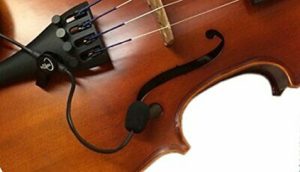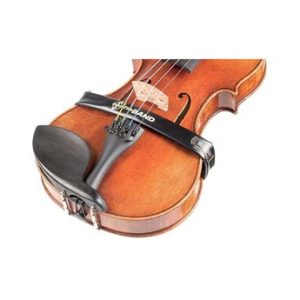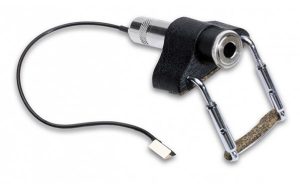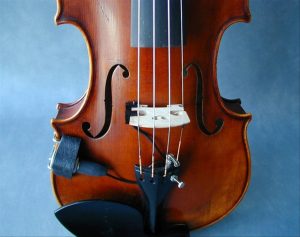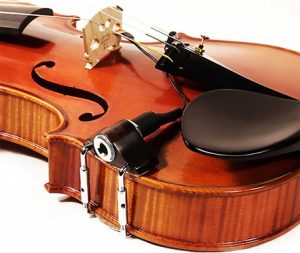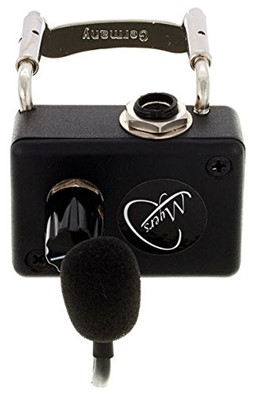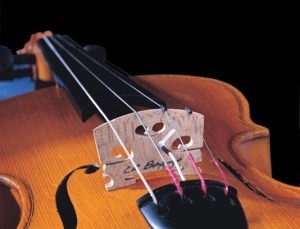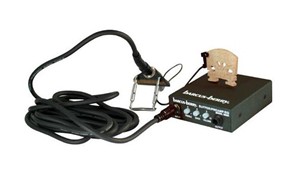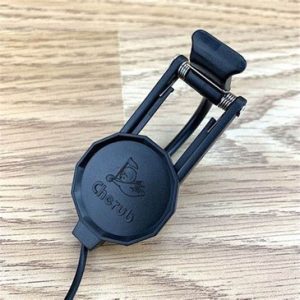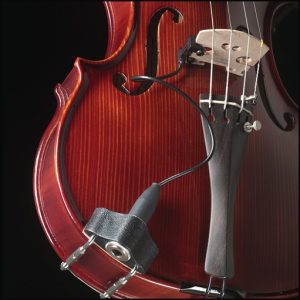9 Best Violin Pickups : Reviews and Buyer’s Guide
Finding a good-sounding and reliable violin pickup can be difficult, especially if you don’t know what to look for. We all want a wonderful sound and volume from our violins, but can’t everyone afford an expensive microphone or amplifier.
That’s why we’ve written this post to go over 9 of the best violin pickups now available so you can make an informed selection before wasting time and money on something that won’t work with your instrument!
Contents
Best Rated Violin Pickup Reviews
We’ll look at each of the nine violin pickups listed below. There are a variety of price points and mounting solutions to choose from. You are the only one who can determine which one will work best for you because you know how and what you perform on your acoustic instrument.
1. The Feather Violin Pickup with Flexible Micro-Gooseneck by Myers Pickups
- The new lightweight powerhouse from Myers Pickups is unveiled. We called it The Feather because it was so light. It’s so little that it can be placed on a variety of instruments without requiring any modifications or long-term installation while yet faithfully amplifying the natural tone and beauty of your instrument!
- Fully fitted with an active, internally powered preamp to offer the richest sound your instrument can create! Each pickup is rigorously checked before delivery and comes with a power source (supplied). There’s no need for phantom power! Most wireless systems are compatible!
- Plug in and play right out of the package! Every piece of mounting hardware is included.
- Transform your instrument into an acoustic/electric instrument with volume in a matter of seconds! Almost any musical instrument can be used!
- Made in the United States of America.
At number one, we have to recommend Myers Pickups’ Feather Violin Pickup. The Feather’s mounting hardware is simple and basic, so you won’t have to worry about it slipping off your violin. Because the pickup is essentially a miniature microphone, you can use the gooseneck to move the microphone near to an F-hole to get the sound you desire.
There is no need for an external power source because the pickup contains an internal battery. Aside from the violin, all you need is an instrument cord to connect the pickup to the amp or PA system.
While we’re on the subject of violin pickups, The Feather also works on guitars, ukuleles, percussion instruments, and some woodwinds.
Aside from its accurate reproduction of the acoustic sound it amplifies, one of the best features of this pickup is its weight (or lack thereof). This isn’t called The Feather by Myers Pickups because it tickles. It’s so light that it’s hard to believe. This is a fantastic pickup that we highly suggest because of its performance.
2. Headway The Band Violin Pickup
- Easy instant fitting and transferability
- Warmth and clarity of tone
- Reduced feedback and body boom
When amplifying acoustic instruments, feedback is frequently a serious concern. With feedback rejection technology, The Band eliminates this issue, making this a fantastic pickup.
Wrap The Band around the bout of your violin to mount it. Because The Band sits beneath your violin’s strings, there’s almost no chance of your bow and pickup becoming tangled.
The Band doesn’t produce a sound as pure as putting a microphone in the F-hole of your violin or viola (The Band readily fits either), but it comes close. The jack emits a passive signal, allowing you to connect your cable directly to your amplifier without any additional steps.
This is a fantastic piece of gear that will be more than enough for your amplification needs.
3. Fishman V-200 Classic Series Professional Violin Pickup
- Piezo-ceramic pickup
- Lightweight to minimize muting
- An impedance matching preamp is recommended, but not required
In the V-200 Classic, Fishman includes a piezo-electric pickup that works differently than typical microphones. Feedback is less of an issue as a result of this, while it is still possible.
This pickup’s best feature is its mounting mechanism. It works in a similar way to the mounting method that secures everyone’s chinrest. That means the V-200 will stay where you set it, and its mounting system is one we’re familiar with.
The piezo-electric pickup on the quarter-inch carpenter jack has a lead coming off of it, which you insert between the wood of the violin bridge. It then picks up the string vibrations and transfers them to the amplifier or PA system via the cable.
While this is a fantastic tiny instrument, it works best in conjunction with a preamp. Although it can be used without a preamp, Fishman advises against it. Nonetheless, this is a fantastic purchase.
4. Barcus Berry 3100 Clamp-on Bridge Violin Pickup
Barcus Berry 3100 Clamp-On Bridge Violin Piezo Pickup
- Connects to the 3100P output jack via cable and clamps easily to the violin bridge. It has a wide frequency response and good string balance.
- The feedback rejection mechanism delivers exceptional signal isolation for clear, accurate violin sound reproduction.
- Attachment and removal are simple with no additional tools or holes to drill.
The pickups of Barcus Berry are well-known. This one appeals to me because it’s a piezo pickup that doesn’t require any wedging, which is convenient for those of us who don’t like shoving things into the complex wood of the bridge.
The pickup body is held in place by turnbuckles similar to the chinrest, and the piezo is clamped to the bridge. This ensures that string vibrations are effectively transferred from the bridge to the pickup. The disadvantage is that if the screws in the mounting clamp aren’t tightened enough, they can rattle.
Clamping anything to the bridge, according to some players, also serves as a mute. The volume gained by amplifying the violin, on the other hand, is likely to cancel this out.
When properly installed, the 3100 will perform well for you and your amplified game. It’s also available for fractional-sized violins and violas, so if you don’t play a full-sized instrument, you can still use this pickup without any hassles or alterations to your violin or pickup.
5. Kremona KNA VV-3 Violin Pickup
KNA VV-3 Detachable Passive Piezo Pickup for Violin and Viola
- The genuine sound of your instrument is delivered by a lightweight, wood-encased sensor.
- The 1/4″ Carpenter jack is made of solid ebony with a cork-lined clamp that keeps it firmly attached to the instrument.
- When not in use, it can be removed or left in place.
The VV-3’s carpenter jack (encased in wood to blend in with your instrument) is another piezo pickup that attaches like a chinrest. Because the wood-encased sensor wedges into the bridge, muting isn’t as difficult as it would be with a sensor that clamps onto the bridge.
Because it isn’t a microphone, the piezo pickup has fewer occurrences of feedback, yet it isn’t immune to it.
Kremona provided us with a portable piece of equipment that does the job well. Because this is not a microphone, you won’t receive perfect sound reproduction, but piezo pickups are well-known and well-proven, so this shouldn’t be an issue.
6. Myers Pickups Carpenter Jack Violin Pickup
Violin Pickup Carpenter Jack with Micro-Gooseneck by Myers Pickups
- Violin Pickup with Micro-Gooseneck Flexibility! The new carpenter jack mount is included!
- On the market today, the smallest (all-in-one) active/preamp pickup!
- Transform your instrument into an acoustic/electric instrument in an instant!
- Almost any musical instrument can be used! String instruments will love it!
Myers creates fantastic work. The Carpenter Jack is another fantastic Myers pickup, which comes as no surprise. The Carpenter Jack is quite similar to The Feather, with the exception of the mount, which is also very light. Our pickup uses the same turnbuckle, chinrest-style mounting method as the others on this list, resulting in a very stable attachment.
The built-in preamp includes a built-in battery, so you can plug it in and forget about it. You’ll be well on your way to producing a faithful rendition of your acoustic instrument’s tone if you use the gooseneck to position the microphone above the F-hole.
The Carpenter Jack pickup evokes the word “unintrusive” due to its modest size, and it appears to be the type of pickup you can soon forget it on your instrument, allowing you to just play, man.
7. LR Baggs Violin Pickup with External Jack Mount
- Superieur Despiau “Two Tree” maple bridge
- Even string-to-string balance
- Highly feedback-resistant
The LR Baggs pickup is unusual in that it is permanently attached to the bridge of the violin, which means it may need to be properly installed. You won’t have to worry about it again once you’ve trimmed and set the Superieur Despiau “Two Tree” maple bridge.
Because this piezo pickup converts vibrations into electronic signals, it has excellent dynamic responses, and feedback is exceedingly rare because there is no diaphragm for a microphone.
Another fantastic feature of this pickup is that it allows you to perform some things that an electric violin would allow you to accomplish while still preserving the natural sound of your acoustic violin or viola.
A turnbuckle-style device secures the external jack to the violin. You can play without worrying about it once it’s installed; the bridge is very permanent, and the jack isn’t going anywhere either.
Overall, this is a fantastic setup.
8. Barcus Berry with Preamp 3110 Clamp-on Bridge Violin Piezo Pickup
- Connects to the 3100P output jack via cable and clamps easily to the violin bridge. Wide frequency response and excellent string balance are available.
- Dimensions of the package: 6.096 H x 16.002 L x 21.336 W (centimetres)
- 1.45 pound package weight
The clamp-on mounting mechanism from Barcus Berry secures the piezo-electric pickup to the bridge without the need to wedge it into the wood. The 3110, like other piezos, has a low risk of feedback, and when combined with the preamp, it produces a pleasant, firm sound.
Some of the pickups on this list include built-in preamps, while others just recommend using one but do not require it. Even so, having one improves the sound of any pickup, so having one with the 3110 ensures solid performance.
You can leave this pickup on all the time or add and delete it as needed. If you don’t get the clamp screws tight enough, you’ll have rattling, just like the other Barcus Berry on this list, so keep that in mind. However, it is simple to set up, which is usually a good thing.
9. Andoer Cherub WCP-60V Violin Pickup
- A professional pickup for violin- 1/4” jack with 2.5m cable.
- Clip-on design, easy to fix on violin stably.
- Able to eliminate external noise.
This is our budget pick, a piezo pickup that is extremely economical. The transducer itself is designed to fit into an F-hole, however, it is not universal. It works well with F-holes that are larger.
The Cherub brings plastic materials to the table as an economical choice, resulting in a lightweight piece of equipment that doesn’t exactly inspire trust in its endurance.
In terms of sound creation, the Cherub performs its job, but because the pickup collects vibrations from the entire violin’s body rather than the bridge, as other piezos do, it will pick up finger sounds and other squeaks.
How to Choose a Violin Pickup: A Buyer’s Guide
Pickups are electrical components found on electric guitars, basses, violins, and a variety of other instruments.
The vibrations of an instrument’s strings are converted into electronic signals by these devices, which act similarly to microphones.
The electric pickups convert the signals, which are then transmitted to an amplifier, where they are projected at a volume that the instrument could not create on its own.
On both hollow-body acoustic-electric violins and solid-body quiet violins, electric pickups are employed.
You’ll find a lot of wonderful models to choose from while looking for pickups for your violin.
Types of Pickups
There are numerous various sorts of violin pickup designs due to the many different types of violin designs, player needs, and sound preferences.
Removable or permanent violin pickups are available. There are various different types of violin pickups within the categories of removable and permanent violin pickups.
Removable Violin Pickups
Easy fit violin pickups, as their name implies, are removable violin pickups that are simple to install on a violin as needed.
These pickups are frequently clipped onto violins and fastened to another location on the violin so that the vibrations of the strings can be picked up by the pickup.
In terms of sound quality, however, easy fit pickups are not necessarily the finest violin pickup options.
Bridge-mounted violin pickups are temporarily attached to the bridge of a violin, allowing them to directly receive the vibrations of the strings.
As a result, the signals produced by these pickups are extremely precise.
However, some bridge-mounted pickups modify the sound of violins, which can be beneficial or detrimental depending on your personal preferences.
A pickup that is temporarily inserted beneath the posts of a violin’s bridge is known as an under-the-bridge violin pickup.
This sort of pickup takes string vibrations straight from the bridge and the top of the violin’s acoustic chamber, allowing it to create an extremely accurate signal.
Under-the-bridge pickups, on the other hand, can be time-consuming to install and remove.
If you want an amplified sound that is true to what you hear from your violin, under-the-bridge pickups are ideal, but you can keep the pickup on your violin if you want.
A clip-on microphone is a form of violin pickup that may be connected to a violin to amplify its sound.
A comparable effect can be found in the realms of music and theatre, such as with auditorium design, where clip-on microphones must be put in certain positions on each violin to receive and magnify the best tones.
As a result, setting up a clip-on microphone and getting the best sound takes some time and care.
A contact microphone is a form of violin pickup that picks up vibrations by making touch with the violin’s surface.
These pickups function as both microphones and pickups, combining the best of both worlds.
Because contact microphones are microphones, they must be properly placed on a violin to provide the greatest results.
Permanent Violin Pickups
Bridge replacement pickups are permanent violin pickups that are installed in place of the original bridge.
Bridge replacement pickups are, in reality, violin bridges.
These bridges, on the other hand, are equipped with electronics that allow them to output vibrations received directly from violin strings.
Bridge replacement pickups are excellent permanent violin pickups since they only require you to connect your violin to an amplifier when you need to electrify it.
Luthiers will need to professionally install these permanent pickups.
Installing a bridge replacement pickup on your violin, as a result, might be pricey.
What is the Difference Between Passive and Active Pickups?
Passive and active pickups are two types of stringed instrument pickups that translate string vibrations in different ways.
Passive Pickups
Magnets are used in passive pickups to create electric impulses from string vibrations.
Passive pickup technology, on the other hand, is older and has been constantly improved due to the extreme sensitivity of passive pickups to interference and feedback.
Passive pickups are frequently combined with pre-amplifiers to mitigate these effects and a few other drawbacks. Pre-amplifiers cleanly convert the lower electronic signals produced by passive pickups into stronger output signals.
Pre-amplifiers, often known as pre-amps, allow passive pickup signals to be amplified enough to be processed further if required.
The signals processed from passive pickups would have a lot of noise and distortion without pre-amplifiers, providing unpleasant sounds for listeners.
Active Pickups
Through the use of circuits, batteries, and other technologies, active pickups are capable of producing powerful electric signals.
Active pickups use magnets in the same way as passive pickups do, but the magnets used in active pickups are smaller, making them less sensitive to interference, noise, and feedback.
Pre-amps are also used in conjunction with active pickups.
Active pickups are advantageous because they allow musicians to have consistent sound qualities, in addition to their strong electric impulses.
Due to the equal set of advantages and disadvantages that both passive and active pickups have to provide, both are still employed on instruments.
Due to their capacity to pick up tiny frequencies, passive pickups generate a wider range of tones than active pickups, despite their susceptibility to excessive noise.
Active pickups, on the other hand, successfully clean up the sounds of lower-quality instruments and generate appealing tones.
Active pickups also don’t need extra pre-amps because they’re already built into the pickup’s technology.
Because active pickups require power to operate, they can basically render an instrument worthless if the batteries expire.
Important Features
When looking for an electric pickup for your violin, there are a few aspects that you might prefer over others.
Its Sound
One of the most significant factors to consider when purchasing a pickup for your violin is the sound it produces.
You want one that not only sounds good to your ears but also sounds the most like your violin’s natural tone.
However, many pickups require pre-amps, which can further affect the sound of a violin.
However, you can use a number of electronic effects to change the sound of your violin.
If you want to use effects with your violin, purchasing an electric pickup that produces the most natural sound may not be as crucial to you.
Ease of Setup
Another crucial factor to consider is how simple it is to set up your violin pick up, and you should search for one that is quick and straightforward to use.
Many violin pickups are simple to install, but there are a few that aren’t.
A bridge replacement pickup may be a good option for you if you don’t want to have to set up your violin’s pickup every time you play.
There are various versions with modest designs if you want an electric pickup that isn’t too loud.
Some electric pickups are prominent and immediately alter the appearance of a violin, while others are barely detectable by audiences.
Alternatively, you can choose a permanent bridge replacement pickup that has a small output jack.
Best Pickup Brands
When it comes to picking out electric pickups for your violin, you have a lot of alternatives.
The “The Band” model from Headway Music Audio is a very popular model.
The Band is a passive pickup that uses a Velcro mechanism to wrap around the entire body of a violin.
The Band’s passive pickup mechanism lets it to pick up a wide spectrum of tones.
Unlike many passive pickups, however, The Band does not suffer from feedback.
Barcus Berry makes a variety of bridge-mounted violin pickups, but the 3100 is a favourite among violinists.
The Barcus Berry 3100 easily clamps onto a violin’s bridge and includes an output jack that clamps into the side of the violin, making installation and removal simple for violinists.
The 3100 includes a function that eliminates feedback, resulting in a clear and natural sound.
“The Feather” is a clip-on microphone style of electric pickup made by Myers Pickup.
The Feather has a built-in pre-amp that cleans up the signal, resulting in a more natural tone for violins.
If a violinist wants to make active adjustments to the microphone’s output signal, they can do so by turning the volume knob on The Feather.
The Feather, like most clip-on microphones that are essentially omnidirectional, needs to be fine-tuned to accentuate the greatest tones from a violin.
Price
Electric violin pickups are available at a variety of rates.
Removable pickups will cost as little as $40, while permanent pickups will cost roughly $500.
For example, the Barcus Berry 3100 costs a little more than $100.
If you decide to buy a permanent violin pickup, you’ll also have to consider the cost of installation, which varies depending on who you bring your violin to, how busy they are with other instruments, and other considerations.
Before you buy a permanent electric pickup for your violin, talk to your local violin store.
Conclusion: Which Violin Pickup Should You Buy?
If you’re looking for a violin pickup, chances are you’re seeking a high-quality piece of gear and aren’t genuinely hoping to save money.
Myers’ The Feather is a good choice. It’s simple to install, generates excellent sound, and is so light that you’ll quickly forget it’s there.
Nothing on this list is garbage, but if you want the finest of the best, The Feather will meet your amplification needs without sacrificing your sound or performance.
Active pickups are more expensive, and passive pickups are less costly.
Violin Pickup FAQ’s
Is it necessary for me to purchase a second violin?
Some people may purchase an instrument in order to learn how to play it briefly, perhaps for a single song with their band or something similar, and they will certainly want to spend as little money as possible. If your ambition is to become a great violinist, you should probably invest in a new instrument.
Is the violin an appropriate instrument for me?
If you’re one of those people who tries a new activity for a few weeks and then loses interest and moves on to something else, a violin might be a suitable fit for you.
Which violin is the smallest for a beginner?
The smallest size is 1/64, so if your child’s circumference is less than 13″, this is the size they’ll require. If you have a violin teacher, don’t be afraid to seek assistance from him or her; he or she may even have violins of various sizes available for you to try.

